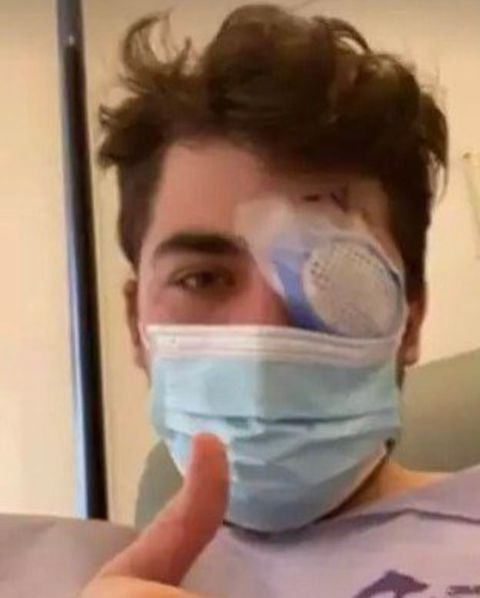The one thing that helped Chad Groeschen see is the same thing that took his sight away.
Tricked by “Night and Day” contact lenses, which claim you can sleep while wearing them, the man from Cincinnati woke up with severe pain in his eye and trouble seeing.
Groeschen developed a serious infection, likely caused by sleeping with the extended-wear lenses for several nights in a row.
Now, he needs a cornea transplant and is warning others to “maintain impeccable hygiene” to avoid the same fate.

In 2015, Chad Groeschen woke up with severe pain in his left eye and could barely see.
“Halfway through the day, my eyes started itching. I thought it was allergies, so I took my contacts out. The next morning, my left eye started to turn cloudy,” he explained. “I used ‘Night and Day’ contacts, which I thought I could wear for 30 days straight. I only took them out about once a week because I figured it was better not to mess with my eyes.”
But that was not the right choice.
Although these lenses are marketed for “continuous wear,” a study from the American Academy of Ophthalmology shows that wearing them overnight can increase the risk of eye infections. When Groeschen, then 39, saw a specialist, he learned he had a corneal ulcer infected with Pseudomonas bacteria, likely from his extended-wear lenses. Doctors told him that the contacts acted like a petri dish, holding bacteria that attacked his eye.
Soon, Groeschen, a sculptor, could no longer see out of his left eye and was told he would probably need a corneal transplant to restore his sight.
The Centers for Disease Control (CDC) found that most of the 41 million contact lens wearers in the U.S. do at least one risky thing that can harm their vision. The study showed that 82.3% of people wear their lenses longer than recommended, over half don’t change their solution, and 50% sleep in their lenses.
“Good vision is important for overall well-being and independence, so it’s vital to follow proper care for contact lenses,” said CDC Medical Epidemiologist Jennifer Cope, M.D., M.P.H. Many wearers don’t understand how to care for their lenses properly.
With so many people risking their eyesight, infections can happen more often than many realize. According to the CDC, about one in every 500 contact lens users develops a serious eye infection each year that could lead to blindness.
In December 2022, Mike Krumholz, now 22, may face permanent blindness after napping for 40 minutes with daily disposable contacts still in. After the nap, he showered, took out his contacts, and then went to bed.
“The next day, I woke up with an itchy, ‘gunky’ eye that was sensitive to light. At first, I thought it was allergies, but it was much worse,” Krumholz said. Doctors told him he had a rare parasite called Acanthamoeba keratitis, which can cause blindness. They explained that sleeping with contacts, even for a short time, could let the parasite infect his cornea.
Krumholz shared his experience on Facebook to warn others. “There is no pain worse than this. Even strong medicines don’t help. I don’t know if I’ll ever regain my vision at just 21 years old,” he wrote. He added, “I haven’t been able to go outside for over 30 days, and I have my hurricane shutters up to block out light.”
After treatment for the parasite, Krumholz was told the best case is that he’ll be free of it by late summer 2023, when he can have a corneal transplant to remove the infected part of his eye.
“I know I might never see fully again, but I don’t know how much vision I’ll get back,” he said.
### Tips to Prevent Eye Infections (CDC):
1. **Wash Your Hands**: Always wash your hands with soap and water and dry them well before touching your contact lenses.
2. **Remove Contacts Before Sleeping**: Take out your contacts before you sleep, shower, or swim.
3. **Clean Your Contacts**: Rub and rinse your contacts in disinfecting solution every time you take them out.
4. **Clean the Case**: Rub and rinse your contact lens case with solution, dry it with a clean tissue, and store it upside down with the caps off after each use.
5. **Change Your Case Regularly**: Replace your contact lens case at least once every three months.
6. **Don’t Top Off Solution**: Avoid adding fresh solution to old solution in your lens case.
7. **Have Backup Glasses**: Keep a backup pair of glasses in case you need to take out your contacts.
Koerschner also warns, “If anything happens to your eye, seek a specialist immediately and keep your eye hygiene very clean.”
Always remember to practice good eye hygiene! It might feel unnecessary sometimes, but it’s worth it for your eye health.
